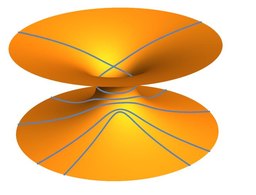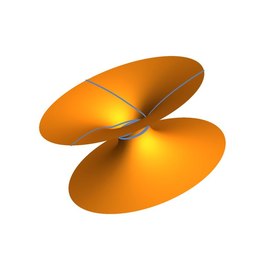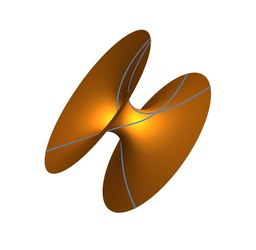Ellis wormhole

TheEllis wormholeis the special case of theEllis drainholein which the 'ether' is not flowing and there is no gravity. What remains is a puretraversable wormholecomprising a pair of identical twin, nonflat, three-dimensional regions joined at a two-sphere, the 'throat' of the wormhole. As seen in the image shown, two-dimensional equatorial cross sections of the wormhole arecatenoidal'collars' that are asymptotically flat far from the throat. There being no gravity in force, aninertial observer(test particle) can sit forever at rest at any point in space, but if set in motion by some disturbance will follow ageodesicof an equatorial cross section at constant speed, as would also a photon. This phenomenon shows that in space-time the curvature of space has nothing to do with gravity (the 'curvature of time’, one could say).
As a special case of theEllis drainhole,itself a 'traversable wormhole', the Ellis wormhole dates back to the drainhole's discovery in 1969 (date of first submission) by H. G. Ellis,[1] and independently at about the same time by K. A. Bronnikov.[2]
Ellis and Bronnikov derived the original traversable wormhole as a solution of the Einsteinvacuum field equationsaugmented by inclusion of a scalar fieldminimally coupled to the geometry of space-time with coupling polarity opposite to the orthodox polarity (negative instead of positive).Some years laterM. S. MorrisandK. S. Thornemanufactured a duplicate of the Ellis wormhole to use as a tool for teaching general relativity,[3] asserting that existence of such a wormhole required the presence of 'negative energy', a viewpoint Ellis had considered and explicitly refused to accept, on the grounds that arguments for it were unpersuasive.[1]
The wormhole solution[edit]
The wormhole metric has the proper-time form
where
andis the drainhole parameter that survives after the parameterof the Ellis drainhole solution is set to 0 to stop the ether flow and thereby eliminate gravity. If one goes further and setsto 0, the metric becomes that ofMinkowski space-time,the flat space-time of thespecial theory of relativity.
In Minkowski space-time every timelike and every lightlike (null) geodesic is a straight 'world line' that projects onto a straight-line geodesic of an equatorial cross section of a time slice of constantas, for example, the one on whichand,the metric of which is that of euclidean two-space in polar coordinates,namely,
Every test particle or photon is seen to follow such an equatorial geodesic at a fixed coordinate speed, which could be 0, there being no gravitational field built into Minkowski space-time. These properties of Minkowski space-time all have their counterparts in the Ellis wormhole, modified, however, by the fact that the metric and therefore the geodesics of equatorial cross sections of the wormhole are not straight lines, rather are the 'straightest possible' paths in the cross sections. It is of interest, therefore, to see what these equatorial geodesics look like.
Equatorial geodesics of the wormhole[edit]



The equatorial cross section of the wormhole defined byand(representative of all such cross sections) bears the metric
When the cross section with this metric is embedded in euclidean three-space the image is the catenoidshown above, withmeasuring the distance from the central circle at the throat, of radius,along a curve on whichis fixed (one such being shown). Incylindrical coordinatesthe equationhasas its graph.
After some integrations and substitutions the equations for a geodesic ofparametrized byreduce to
and
whereis a constant. Ifthenandand vice versa. Thus every 'circle of latitude' (constant) is a geodesic. If on the other handis not identically 0, then its zeroes are isolated and the reduced equations can be combined to yield the orbital equation
There are three cases to be considered:
- which implies thatthus that the geodesic is confined to one side of the wormhole or the other and has a turning point ator
- which entails thatso that the geodesic does not cross the throat atbut spirals onto it from one side or the other;
- which allows the geodesic to traverse the wormhole from either side to the other.
The figures exhibit examples of the three types. Ifis allowed to vary fromtothe number of orbital revolutions possible for each type, latitudes included, is unlimited. For the first and third types the number rises to infinity asfor the spiral type and the latitudes the number is already infinite.
That these geodesics can bend around the wormhole makes clear that the curvature of space alone, without the aid of gravity, can cause test particles and photons to follow paths that deviate significantly from straight lines and can create lensing effects.
Dynamic Ellis wormhole[edit]
There is a dynamic version of the Ellis wormhole that is a solution of the same field equations that the static Ellis wormhole is a solution of.[4] Its metric is
where
being a positive constant. There is a 'point singularity' atbut everywhere else the metric is regular and curvatures are finite. Geodesics that do not encounter the point singularity are complete; those that do can be extended beyond it by proceeding along any of the geodesics that encounter the singularity from the opposite time direction and have compatible tangents (similarly to geodesics of the graph ofthat encounter the singularity at the origin).
For a fixed nonzero value ofthe equatorial cross section on whichhas the metric
This metric describes a 'hypercatenoid' similar to the equatorial catenoid of the static wormhole, with the radiusof the throat (where) now replaced byand in general each circle of latitude of geodesic radiushaving circumferential radius.
Forthe metric of theequatorial cross section is
which describes a 'hypercone' with its vertex at the singular point, its latitude circles of geodesic radiushaving circumferencesUnlike the catenoid, neither the hypercatenoid nor the hypercone is fully representable as a surface in euclidean three-space; only the portions where(thus whereor equivalently) can be embedded in that way.
Dynamically, asadvances fromtothe equatorial cross sections shrink from hypercatenoids of infinite radius to hypercones (hypercatenoids of zero radius) atthen expand back to hypercatenoids of infinite radius. Examination of the curvature tensor reveals that the full dynamic Ellis wormhole space-time manifold is asymptotically flat in all directionstimelike, lightlike, and spacelike.
Applications[edit]
- Scattering by an Ellis wormhole[5]
- Gravitational lensingin the Ellis wormhole
References[edit]
- ^ab H. G. Ellis (1973). "Ether flow through a drainhole: A particle model in general relativity".Journal of Mathematical Physics.14(1): 104–118.Bibcode:1973JMP....14..104E.doi:10.1063/1.1666161.
- ^ K. A. Bronnikov (1973). "Scalar-tensor theory and scalar charge".Acta Physica Polonica.B4:251–266.
- ^ M. S. Morris; K. S. Thorne (1988)."Wormholes in spacetime and their use for interstellar travel: A tool for teaching general relativity".American Journal of Physics.56(5): 395–412.Bibcode:1988AmJPh..56..395M.doi:10.1119/1.15620.
- ^ H. G. Ellis (1979). "The evolving, flowless drainhole: A nongravitating-particle model in general relativity theory".General Relativity and Gravitation.10(2): 105–123.Bibcode:1979GReGr..10..105E.doi:10.1007/bf00756794.S2CID122255430.
- ^ G. Clément (1984). "Scattering of Klein-Gordon and Maxwell waves by an Ellis geometry".International Journal of Theoretical Physics.23(4): 335–350.Bibcode:1984IJTP...23..335C.doi:10.1007/bf02114513.S2CID120826946.
- ^ F. Abe (2010). "Gravitational microlensing by the Ellis wormhole".The Astrophysical Journal.725(1): 787–793.arXiv:1009.6084.Bibcode:2010ApJ...725..787A.doi:10.1088/0004-637x/725/1/787.S2CID118548057.
- ^ C.-M. Yoo; T. Harada; N. Tsukamoto (2013). "Wave effect in gravitational lensing by the Ellis wormhole".Physical Review D.87(8): 084045–1–9.arXiv:1302.7170.Bibcode:2013PhRvD..87h4045Y.doi:10.1103/physrevd.87.084045.S2CID119262200.
- ^ Y. Toki; T. Kitamura; H. Asada; F. Abe (2011). "Astrometric image centroid displacements due to gravitational microlensing by the Ellis wormhole".Astrophysical Journal.740(2): 121–1–8.arXiv:1107.5374.Bibcode:2011ApJ...740..121T.doi:10.1088/0004-637x/740/2/121.S2CID119113064.
- ^ V. Perlick (2004)."Exact gravitational lens equation in spherically symmetric and static spacetimes".Physical Review D(Submitted manuscript).69(6): 064017–1–10.arXiv:gr-qc/0307072.Bibcode:2004PhRvD..69f4017P.doi:10.1103/physrevd.69.064017.S2CID119524050.
- ^ T. K. Dey; S. Sen (2008). "Gravitational lensing by wormholes".Modern Physics Letters A.23(13): 953–962.arXiv:0806.4059.Bibcode:2008MPLA...23..953D.doi:10.1142/s0217732308025498.S2CID7909286.
- ^ K. K. Nandi; Y.-Z. Zhang; A. V. Zakharov (2006). "Gravitational lensing by wormholes".Physical Review D.74(2): 024020–1–13.arXiv:gr-qc/0602062.Bibcode:2006PhRvD..74b4020N.CiteSeerX10.1.1.341.1533.doi:10.1103/physrevd.74.024020.S2CID119454982.




![{\displaystyle {\begin{aligned}d\sigma ^{2}&=d\rho ^{2}+r^{2}(\rho )\,d\Omega ^{2}\\&=d\rho ^{2}+\left(\rho ^{2}+n^{2}\right)\,d\Omega ^{2}\\&=d\rho ^{2}+\left(\rho ^{2}+n^{2}\right)\,\left[d\vartheta ^{2}+(\sin \vartheta )^{2}\,d\varphi ^{2}\right]\;\;\end{aligned}}}](https://wikimedia.org/api/rest_v1/media/math/render/svg/1039478ffeea9c5b36ea1927a1e96b24290192e2)





![{\displaystyle [\rho ,\varphi ]}](https://wikimedia.org/api/rest_v1/media/math/render/svg/633afd63610151049ee2d67c86eaf14eed14e575)




![{\displaystyle [r,\varphi ,z]}](https://wikimedia.org/api/rest_v1/media/math/render/svg/7acc0f84072f648c12716701597a32f5b5aae0bd)























![{\displaystyle d\sigma ^{2}=d\rho ^{2}+\left[\left(1+a^{2}\right)\rho ^{2}+a^{2}c^{2}t^{2}\,\right]\,d\Omega ^{2}\,,}](https://wikimedia.org/api/rest_v1/media/math/render/svg/beb7ae8cd6becd5bfb4a5f61eeb7c30099d403bc)




![{\displaystyle {\begin{aligned}ds^{2}&=d\rho ^{2}+r^{2}(t,\rho )\,d\varphi ^{2}\\&=d\rho ^{2}+\left[\left(1+a^{2}\right)\rho ^{2}+a^{2}c^{2}t^{2}\,\right]\,d\varphi ^{2}\,.\end{aligned}}}](https://wikimedia.org/api/rest_v1/media/math/render/svg/e26337c1dc50ac887c980afa453a2e219a6a0273)










